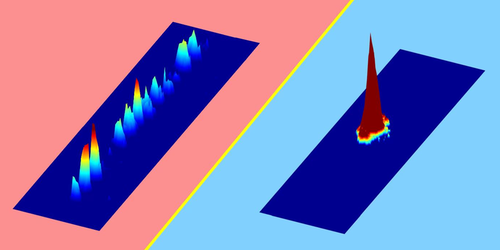A Wire on the Edge
In a 1D wire, the presence of impurities can halt the flow of any noninteracting particles, a process known as localization. Localized and conducting noninteracting particles cannot coexist in a 1D wire, so these impurities can limit the wire’s transport capabilities. Now Yunfei Wang from Shanxi University, China, and colleagues show that researchers could get around this localization problem if they instead use interacting particles [1]. The team says that the insights provided by their 1D study could be relevant to 3D systems.
For their experiments, the team created an artificial wire in a “synthetic” dimension defined by the momentum states of ultracold cesium atoms. They cooled the atoms to 10 nK, a temperature at which the atoms formed a Bose-Einstein condensate. Shining lasers on the atoms induced in the atoms controlled momentum-state changes such that an atom changing momentum states emulated a particle traveling through a wire. The team included impurities in the system by tuning the lasers to produce energy mismatches between the energy states of different atoms. The resulting interactions between atoms echoed the interactions between particles. Finally, by detecting the atoms’ momenta after experiencing momentum-state changes, the team inferred the analogous particle position in the wire.
The team’s measurements show that a wire with interacting particles supports rich quantum transport behavior. Depending on the strength of the interactions and the level of impurities in the wire, it can behave as either a conductor, an insulator, or both, improving the wire’s transport abilities. The team says that their atom wire is analogous to a disordered optical waveguide. As such they say that their results could help in designing strategies to improve information propagation in photonic lattices.
–Martin Rodriguez-Vega
Martin Rodriguez-Vega is an Associate Editor for Physical Review Letters.
References
- Y. Wang et al., “Observation of interaction-induced mobility edge in an atomic Aubry-André wire,” Phys. Rev. Lett. 129, 103401 (2022).




